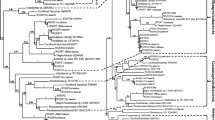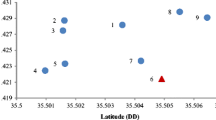Abstract
Ten phenol-degrading bacterial strains were isolated from three geographically distant environments. Five of them, identified as Diaphorobacter, Acidovorax, Acinetobacter (two strains), and Corynebacterium, could additionally transform pyridine, through the transcription of phenol hydroxylase genes induced both by phenol and pyridine. HPLC-UV and LC-MS analyses indicated that one metabolite (m/e = 96.07) with the same molecular weight as monohydroxylated pyridine was produced from the five phenol-degrading strains, when pyridine was the sole carbon source. Phenol (50 mg l−1) could initially inhibit and later stimulate the pyridine transformation. In addition, heterologous expression of the phenol hydroxylase gene (pheKLMNOP) resulted in the detection of monohydroxylated pyridine, which confirmed the phenol hydroxylase could catalyze pyridine hydroxylation. Phylogeny of the phenol hydroxylase genes revealed that the genes from the five pyridine-hydroxylating strains form a clade with each other and with those catalyzing the hydroxylation of phenol, BTEX (acronym of benzene, toluene, ethylbenzene, and xylene), and trichloroethylene. These results suggest that pyridine transformation via hydroxylation by phenol hydroxylase may be prevalent in environments than expected.






Similar content being viewed by others

References
Byrne AM, Kukor JJ, Olsen RH (1995) Sequence analysis of the gene cluster encoding toluene-3-monooxygenase from Pseudomonas pickettii PKO1. Gene 154:65–70
Canada KA, Iwashita S, Shim H, Wood TK (2002) Directed evolution of toluene ortho-monooxygenase for enhanced 1-naphthol synthesis and chlorinated ethene degradation. J Bacteriol 184:344–349
Chandra R, Bharagava RN, Kapley A, Purohit HJ (2009) Isolation and characterization of potential aerobic bacteria capable for pyridine degradation in presence of picoline, phenol and formaldehyde as co-pollutants. World J Microbiol Biotechnol 25:2113–2119
Di Gennaro P, Bargna A, Sello G (2011) Microbial enzymes for aromatic compound hydroxylation. Appl Microbiol Biotechnol 90:1817–1827
El-Sayed WS, Ismaeil M, El-Beih F (2009) Isolation of 4-chlorophenol-degrading bacteria, Bacillus subtilis OS1 and Alcaligenes sp. OS2 from petroleum oil-contaminated soil and characterization of its catabolic pathway. Aust J Basic Appl Sci 3:776–783
Houghton C, Cain RB (1972) Microbial metabolism of the pyridine ring: formation of pyridinediols (dihydroxypyridine) as intermediates in the degradation of pyridine compounds by microorganisms. Biochem J 130:879–893
Kaiser JP, Feng YC, Bollag JM (1996) Microbial metabolism of pyridine, quinoline, acridine, and their derivatives under aerobic and anaerobic conditions. Microbiol Rev 60:483–498
Khasaeva F, Vasilyuk N, Terentyev P, Troshina M, Lebedev A (2011) A novel soil bacterial strain degrading pyridines. Environ Chem Lett 9:439–445
Kim MK, Singleton I, Yin CR, Quan ZX, Lee M, Lee ST (2006) Influence of phenol on the biodegradation of pyridine by freely suspended and immobilized Pseudomonas putida MK1. Lett Appl Microbiol 42:495–500
Kolenbrander PE, Weinberger M (1977) 2-Hydroxypyridine metabolism and pigment formation in three Arthrobacter species. J Bacteriol 132:51–59
Lee SK, Lee SB (2001) Isolation and characterization of a thermotolerant bacterium Ralstonia sp. strain PHS1 that degrades benzene, toluene, ethylbenzene, and o-xylene. Appl Microbiol Biotechnol 56:270–275
Mudliar SN, Padoley KV, Matt P, Sureshkumar M, Lokhande SK, Pandey RA, Vaidya AN (2008) Pyridine biodegradation in a novel rotating rope bioreactor. Bioresour Technol 99:1044–1051
O’Loughlin EJ, Sims GK, Traina SJ (1999) Biodegradation of 2-methyl, 2-ethyl, and 2-hydroxypyridine by an Arthrobacter sp. isolated from subsurface sediment. Biodegradation 10:93–104
Olsen RH, Kukor JJ, Byrne AM, Johnson GR (1997) Evidence for the evolution of a single component phenol/cresol hydroxylase from a multicomponent toluene monooxygenase. J Ind Microbiol Biotechnol 19:360–368
Padoley KV, Mudliar SN, Pandey RA (2008) Heterocyclic nitrogenous pollutants in the environment and their treatment options—an overview. Bioresour Technol 99:4029–4043
Powlowski J, Shingler V (1994) Genetics and biochemistry of phenol degradation by Pseudomonas sp. CF600. Biodegradation 5:219–236
Qian H, Edlund U, Powlowski J, Shingler V, Sethson I (1997) Solution structure of phenol hydroxylase protein component P2 determined by NMR spectroscopy. Biochemistry 36:495–504
Shukla OP, Kaul SM (1986) Microbiological transformation of pyridine N-oxide and pyridine by Nocardia sp. Can J Microbiol 32:330–341
Smits THM, Seeger MA, Witholt B, van Beilen JB (2001) New alkane-responsive expression vectors for Escherichia coli and Pseudomonas. Plasmid 46:16–24
Steven BH, Robert ES (1984) Emission of organic air pollutants from shale oil wastewaters. Environ Sci Technol 18:483–490
Sun JQ, Huang X, Chen QL, Liang B, Qiu JG, Ali SW, Li SP (2009) Isolation and characterization of three Sphingobium sp. strains capable of degrading isoproturon and cloning of the catechol 1,2-dioxygenase gene from these strains. World J Microbiol Biotechnol 25:259–268
Sun J-Q, Tang Y-Q, Liu W-Q, Xu L, Zhao J-J, Wu X-L, Chen F-M (2010) Characteristics of degradation of phenolic compounds by two Pseudomonas strains. China Environ Sci 30:1633–1638 (In Chinese)
Sun J-Q, Xu L, Tang Y-Q, Chen F-M, Liu W-Q, Wu X-L (2011) Degradation of pyridine by one Rhodococcus strain in the presence of chromium (VI) or phenol. J Hazard Mater 191:62–68
Sun J-Q, Xu L, Tang Y-Q, Chen F-M, Wu X-L (2012) Simultaneous degradation of phenol and n-hexadecane by Acinetobacter strains. Bioresour Technol 123:664–668
Tinberg CE, Song WJ, Izzo V, Lippard SJ (2011) Multiple roles of component proteins in bacterial multicomponent monooxygenases: phenol hydroxylase and toluene/o-xylene monooxygenase from Pseudomonas sp. OX1. Biochemistry 50:1788–1798
van Berkel WJH, Kamerbeek NM, Fraaije MW (2006) Flavoprotein monooxygenases, a diverse class of oxidative biocatalysts. J Biotechnol 124:670–689
Watson GK, Cain RB (1975) Micrbobial metabolism of pyridine ring-metabolic pathways of pyridine biodegradation by soil bacteria. Biochem J 146:157–172
Xu Y, Fang X, Chen M, Zhang W, Li J, Lin M (2001) The detection of phenol degrading strain in environment with specific primer of phenol hydroxylase gene. Acta Microbiol Sin 41:298–303 (in Chinese)
Xu L, Sun J-Q, Wu X-L, Liu W-Q, Chen F-M, Tang Y-Q (2011) A study on simultaneous chromium (VI)-reduction and phenol-degradation by Acinetobacter sp. WX-19. Acta Mineral Sin 31:654–661 (In Chinese)
Zefirov NS, Agapova SR, Terentiev PB, Bulakhova IM, Vasyukova NI, Modyanova LV (1994) Degradation of pyridine by Arthrobacter crystallopoietes and Rhodococcus opacus strains. FEMS Microbiol Lett 118:71–74
Zhang H, Luo H, Kamagata Y (2003) Characterization of the phenol hydroxylase from Burkholderia kururiensis KP23 involved in trichloroethylene degradation by gene cloning and disruption. Microbes Environ 18:167–173
Zhang T, Ren H-F, Liu Y, Zhu B-L, Liu Z-P (2010) A novel degradation pathway of chloroaniline in Diaphorobacter sp. PCA039 entails initial hydroxylation. World J Microbiol Biotechnol 26:665–673
Acknowledgments
This research was supported by the National Natural Science Foundation of China (31200100, 31070107, and 31225001).
Author information
Authors and Affiliations
Corresponding author
Additional information
Ji-Quan Sun and Lian Xu contribute equally.
Electronic supplementary material
ESM 1
(DOC 549 kb)
Rights and permissions
About this article
Cite this article
Sun, JQ., Xu, L., Tang, YQ. et al. Bacterial pyridine hydroxylation is ubiquitous in environment. Appl Microbiol Biotechnol 98, 455–464 (2014). https://doi.org/10.1007/s00253-013-4818-9
Received:
Revised:
Accepted:
Published:
Issue Date:
DOI: https://doi.org/10.1007/s00253-013-4818-9



